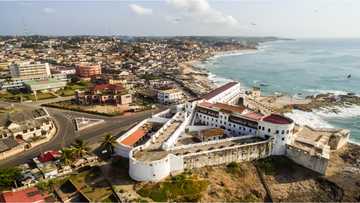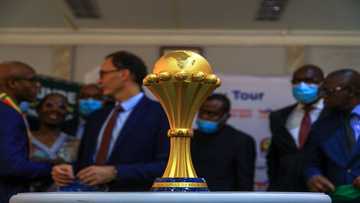Who designed the Ghana flag and what does it stand for?
While almost all Ghanaians probably know what their country flag looks likes, not many might know who designed the Ghana flag and what it stands for. This is the same in almost every country where citizens take pride in the national flag but don't take a keen interest in the history of the flag. The Ghana flag is quite popular in Africa and around the world. This is thanks to the national soccer team which has had success in African football and been able to represent Africa in the FIFA World Cup tournament.

Source: UGC
Every flag is a symbol representing something. When it comes to countries, flags represent autonomy, bravery, or even domination. Ghana, like many African states, had to fight and shed blood to gain independence from their colonial masters. Their flag was, therefore, adopted to represent freedom and self-rule. Decades later, the importance of the flag has not dissipated. On the contrary, with each passing generation, Ghanaians find a way to connect with the flag and celebrate their national heritage.
Historical background
The Ghana flag was originally used in 1957, but it was not until 1966 that it was officially adopted as the national flag. However, it was not the first flag to be flown in the country. The first flag to be flown in Ghana was of the Ashanti Empire which had a yellow-black-green horizontal tricolour.
Apart from the flag of the Ashanti Empire, the Portuguese are also known to have founded a colony on the Gold coast in 1482. As a result, Portugal's flag was used from 1482 to 1637 when the Gold Coast was ceded to the Dutch.
After the Portuguese, the Dutch set up a colony in 1598, and it was administered by the Dutch West India Company. During that time, the flag in use was of the Dutch West India Company which was a red-white-blue horizontal tricolour. After the Dutch, the British took over the Gold Coast in 1872.
The Ghana flag
In 1957, Gold Coast’s name was changed to Ghana after it attained independence from Britain. Previously, the territory had been using the blue ensign of the British colony of the Gold Coast as their flag. As the name of the country was changed, the flag also changed to a red-gold-green horizontal tricolour with a black five-pointed star at the centre.
When Ghana joined with Guinea and Mali, two more stars were added, thus forming the Union of African States. This was the flag of the Union of African States from 1959 to 1963. In 1963, Ghana split from the union and adopted back their first flag with a single star and a white striper in the middle instead of gold.
These were the colours of Kwame Nkrumah’s party and the flag only lasted as long as his rule. The middle colour was changed again to the original gold colour in 1966 following Nkrumah’s overthrow from power in a coup d’état.
READ ALSO: Who Composed the Ghana National Anthem
Ghana flag meaning
The colours of the Ghana national flag represent the traditional Pan-African colours. However, there is a deeper meaning of the colours of the Ghana flag. The red colour at the top of the flag represents bloodshed and the struggle for independence. The gold colour forming the middle stripe is a symbol of the abundance of minerals in Ghana.
The green at the bottom symbolizes Ghana's natural wealth in terms of vegetation cover. Lastly, the five-pointed black star at the centre symbolizes African emancipation. This is not only the national flag of Ghana, but it is also the flag of the Ghanaian president.

Source: UGC
Who designed the Ghana flag?
The beautiful flag of Ghana was developed by Mrs Theodosia Salome Okoh. She was a Ghanaian teacher, stateswoman, and artist. She chose the Pan-African colours to be symbols representing the abundance of natural resources, mineral wealth, and bloodshed during the struggle for independence.
These are three essential things not only in the history of Ghana but also its existence into the future. Mrs. Theodosia settled on the three colours because of the geography of Ghana. Ghana lies in the tropics and blessed with rich vegetation.
READ ALSO: Political history of Ghana in brief
The gold colour was influenced by the mineral-rich nature of our lands and red commemorates those who died or worked for the country's independence. The lone five-pointed star is the symbol of African emancipation and unity in the struggle against colonialism.
Meaning of black star in Ghana flag
The five-pointed star on the flag of Ghana is thought to be a symbol of African emancipation. However, it was not arrived at without giving it significance.
The star was adopted from the flag of the Black Star Line. This was a shipping line incorporated by Marcus Garvey to rescue blacks from slavery and ferry them back to Africa.
Quick facts about the Flag of Ghana
- It was designed by a teacher, stateswoman and artist named Mrs. Theodosia Salome Okoh.
- The flag of Ghana was the second in Africa to use the Pan African colours. Those colours were taken from the flag of Ethiopia because it was the first independent state on the continent, and therefore it became a symbol of freedom.
- The five-pointed star at the centre of the flag of Ghana is sometimes called the Lodestar of African freedom. This is because it was derived from the flag of the Black Star Line incorporated by Marcus Garvey.
- Ghana's national football team got the name Black Stars from the black star at the centre of their country's flag.

Read also
'Ghana Street' still in Germany 63 years after it was named after Ghana for gaining independence
READ ALSO: Political Parties in Ghana and Their Flag Bearers
Theodosia Salome, the lady who designed the Ghana flag, made a significant impact in the country. It remains to be one of the most famous flags in Africa for many reasons. To start with, the flag was only the second to adopt Pan African colours. This was important in the unity of the continent. The commitment of Ghana to the integration of Africa has been doubted based on the fact that their flag has the five-pointed black star, which is the Lodestar of African freedom. It was adopted from the flag of the Black Star Shipping line incorporated by Marcus Garvey to take slaves back to Africa. It is for that reason that the flag of Ghana is also one of the most powerful on the continent.
READ ALSO: Current affairs questions and answers in Ghana
Source: YEN.com.gh





